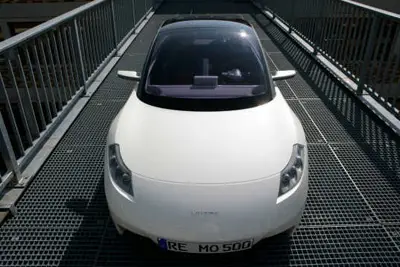 Ford's supercharged V8 ute is a beast… But one that needs taming
Ford's supercharged V8 ute is a beast… But one that needs tamingFord Performance Vehicles (FPV) today launched an exciting new model Series aimed at broadening its appeal to Australia's automotive enthusiasts.
Named in tribute to a fondly-remembered Ford from the late '60s, the new GS sedan and GS Ute are unique limited-edition models offering buyers entry to the FPV family at a very competitive price point.

FPV's GS sedan and Ute are individually-speced to provide a combination of GT-based 302kW V8 engine performance, FPV chassis enhancements, bespoke GS graphics and FPV driver comfort features.
Available in limited numbers, the new FPV GS Series models hark back to the original Falcon GS of 30 years ago, introduced with the XW-model of 1969 and now the second most collectible Ford Falcon behind the GT.
"GS is another iconic badge in Ford's family history in this country," FPV General Manager Rod Barrett said.
"Our aim was to develop a model that provides the performance, prestige and individuality that is a signature of the FPV brand, with its own identifiable model personality, and all at a great price.
"We've achieved all of that and expect the new GS Series models will find their own place in Australian performance motoring folklore."
Developed specifically for the GS Series, the recalibrated FPV 5.4 litre V8 GT engine from the FG-model now produces 302kW of power and 551Nm of torque, driving through a standard six-speed manual transmission.
FPV's engineers have given the GS Series engine the twin throttle bodies and intake system of the GT engine, the GT headers and dual exhaust and a recalibrated ECU, all fine-tuned in an engine development program specific to the GS Series.
"We aimed to provide the GS Series owner with a GT driving experience with this engine … at 302kW it's the perfect entry to our range, which steps up to the turbocharged F6 at 310kW and the full GT-spec V8 at 315kW," Rod Barrett said.

Every FPV GS Series also comes standard with unique GS striping graphics, charcoal cloth interior, FPV GT instrumentation, gear knob, starter button and badging, premium sound system with iPod® and Bluetooth® integration, and dual zone climate control.
There's also '302' graphics on the GS sedan's rear spoiler.
The GS sedan also features 19in Graphite rims and a choice of six exterior colour/stripe combinations, while the GS Ute features 19in Alpine Silver rims, FPV soft tonneau and a choice of three exterior colour/stripe combinations.
Like its namesake from three decades ago, the new FPV GS Series offers a long list of options that include a FPV-spec 4-pot Brembo brake upgrade, a six-speed auto transmission recalibrated specifically for the GS' 302kW engine, leather seats and sat-nav, and, on the Ute only, a hard tonneau with spoiler.
"We have also given the major design elements of the original GS logo a modern interpretation, which adds to the distinctive styling of the GS sedan and Ute," Rod Barrett said.
Production of the GS Series is limited to 250 sedans and 75 Utes.
 FALCON GS HISTORY
FALCON GS HISTORYFirst introduced just over 30 years ago, the Falcon GS was an option pack offered as an 'affordable' and lower-spec alternative to the Falcon GT.
Launched in July 1969 with the then-new XW Falcon range, the GS was an option pack available to dress up the base Falcon and higher-spec Futura models. It continued in the subsequent XY and XA models.
In its initial XW-model guise, the GS option pack added 'rally stripes' to the flanks of the bold new bodywork, chrome-finish full wheel covers, GT-spec instrumentation and three-spoke 'rim blow' sports steering wheel. Later GS packs included other options on the XY and XA models.
Many GS owners along the way also added further options to 'personalise' their cars like bucket seats, centre console, disc brakes, wider tyres, power steering and even the 302 ci Windsor V8.
Today, the GS is fondly remembered by enthusiasts for its mix of sporty good looks and luxury appointments, its rarity and its value as an alternative to the Falcon GT.
FPV GS UteQuick SpinPrice guide (recommended price before statutory and delivery charges): $52,000Crash rating: Five-stars (ANCAP)Fuel: 91 RON ULPClaimed fuel economy (L/100km): 14.2CO2 emissions (g/km): 335Overall Rating: 2.5/5.0Engine/Drivetrain/Chassis: 4.0 for engine and gearbox and 1.0 for chassis.Price, Packaging and Practicality: 4.0/5.0Safety: 4.0/5.0Behind the wheel: 2.0/5.0X-factor: 3.0/5.0
 Skoda OCtavia
Skoda OCtavia  Skoda OCtavia
Skoda OCtavia  Skoda OCtavia
Skoda OCtavia  Skoda OCtavia
Skoda OCtavia  Skoda OCtavia
Skoda OCtavia 












































